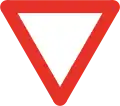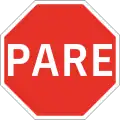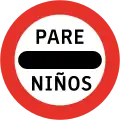
Chile is a signatory to the Vienna Convention on Road Signs and Signals, and therefore its signs are compliant with international standards. Chile uses yellow diamonds for warning signs in common with most of the rest of the Americas. Speed limit signs are a red circle with a white background and the limitation in black, and are in kilometres per hour. There are also some signs unique to Chile. Chile also currently uses a mixture of both types of mandatory signs.
Chile signed the Vienna Convention on Road Signs and Signals on November 8, 1968 and ratified it on December 27, 1974.[1]
Chile drives on the right.
Formerly, Highway Gothic was the official typeface Chile's road signs. New Chilean road signs use Ruta CL, a typeface designed for Chile's road signs.[2]
Regulatory signs
Priority signs
The priority section includes three signs: Give Way, Stop, and Stop for Children. The give way sign indicates to drivers that they must slow down and give way to vehicles on the approaching road, but that they do not need to stop if there is enough room to join or merge. The stop sign indicates to drivers that they must come to a complete stop before joining the approaching road, and is reserved for situations where a raised risk of an accident exists if drivers were not to fully stop before proceeding. The stop for children sign is used by crossing guards, and indicates to drivers that they must come to a complete stop and wait while children cross the road.
Prohibitory signs
The prohibition section includes signs that are used to prohibit and limit certain vehicles from using the road or from making certain movements/actions. Prohibitions are indicated by a red circle with a 45 degree slash from left to right.
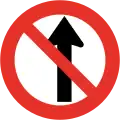 RPO-1
RPO-1
No entry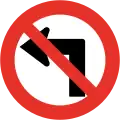 RPO-2a
RPO-2a
No left turn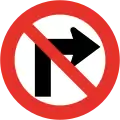 RPO-2b
RPO-2b
No right turn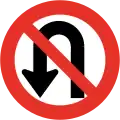 RPO-2c
RPO-2c
No U-turns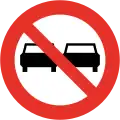 RPO-3
RPO-3
No overtaking RPO-4
RPO-4
No changing lanes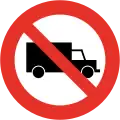 RPO-5
RPO-5
No trucks RPO-6
RPO-6
No motor vehicles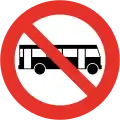 RPO-7
RPO-7
No buses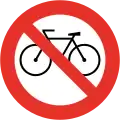 RPO-8
RPO-8
No cycles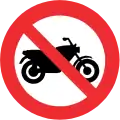 RPO-9
RPO-9
No motorcycles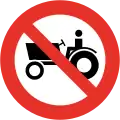 RPO-10
RPO-10
No tractors or other slow-moving vehicles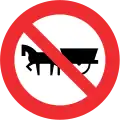 RPO-11
RPO-11
No horse-drawn vehicles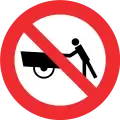 RPO-12
RPO-12
No hand-carts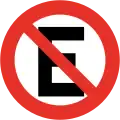 RPO-13
RPO-13
No parking RPO-14
RPO-14
Disabled parking only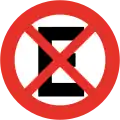 RPO-15
RPO-15
No stopping RPO-16
RPO-16
No pedestrians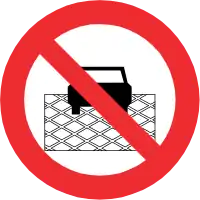 RPO-17
RPO-17
No stopping on the checkered pavement (see: box junction)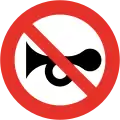 RPO-18
RPO-18
No honking
Restriction signs
The restriction section includes signs that are used to limit the use of the road based on certain characteristics of the road itself, such as limited height. This section also includes the "end of prohibition or restriction" sign which marks the end of any prohibitions and restrictions of the road.
 RR-1
RR-1
Maximum speed limit (50 km/h).svg.png.webp) RR-2
RR-2
Minimum speed limit (40 km/h)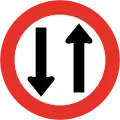 RR-3
RR-3
Two-way traffic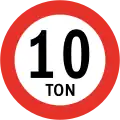 RR-4
RR-4
Weight restriction (10 tonnes (11 short tons))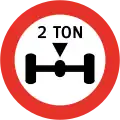 RR-5
RR-5
Weight restriction (2 tonnes per axle)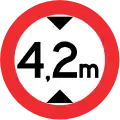 RR-6
RR-6
Height restriction (4.2 metres (14 ft))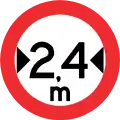 RR-7
RR-7
Width restriction (2.4 metres (7.9 ft))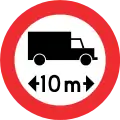 RR-8
RR-8
Length restriction (no vehicles over 10 metres (33 ft) long) RR-9
RR-9
End prohibition or restriction (in this case, the overtaking prohibition has ended) RR-10
RR-10
Electronically tagged vehicles only
Mandatory signs
The obligation section includes signs directing road users to directions and actions they must take or obey. This includes marking one-way streets, mandatory turns and lane control.
.svg.png.webp) RO-1aL
RO-1aL
One-way street (leftwards).svg.png.webp) RO-1aR
RO-1aR
One-way street (rightwards).svg.png.webp) RO-1b
RO-1b
Two-way street RO-1c
RO-1c
Pedestrian zone RO-2a
RO-2a
Keep right RO-2b
RO-2b
Heavy vehicles keep right RO-3a
RO-3a
Turn left only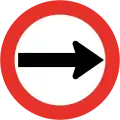 RO-3b
RO-3b
Turn right only RO-3c
RO-3c
Go straight ahead only RO-4
RO-4
Give preference to oncoming traffic RO-4
RO-4
Give preference to uphill traffic RO-5L
RO-5L
Pedestrians walk on your left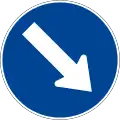 RO-6a
RO-6a
Pass on the right RO-6b
RO-6b
Pass on the left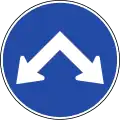 RO-6c
RO-6c
Pass on either side RO-6d
RO-6d
Mini-roundabout RO-7a
RO-7a
Customs checkpoint RO-7b
RO-7b
Police checkpoint RO-8
RO-8
Snow chains mandatory RO-9
RO-9
Low-beam headlights required RO-10
RO-10
Motorcycles only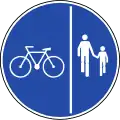 RO-11a
RO-11a
Pedestrians and cyclists keep your side on path RO-11b
RO-11b
Pedestrians and cyclists keep your side on path RO-12a
RO-12a
Buses only in right lane RO-12b
RO-12b
Buses only in left lane
Permission signs
The authorization section includes signs informing road users of actions that are allowed.
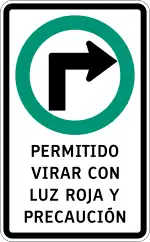 RA-1a
RA-1a
Right turn on red light permitted with caution RA-1b
RA-1b
Left turn on red light permitted with caution RA-2
RA-2
Reserved parking
Warning signs
Warning signs in Chile are diamond-shaped much like in the US and Canada.
Environment signs
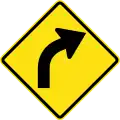 PG-1a
PG-1a
Gentle curve to the right PG-1b
PG-1b
Gentle curve to the left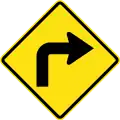 PG-2a
PG-2a
Sharp curve to right PG-2b
PG-2b
Sharp curve to left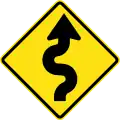 PG-3a
PG-3a
Winding road first curve to right PG-3b
PG-3b
Winding road, first curve to left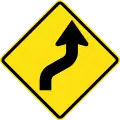 PG-4a
PG-4a
Double gentle curve to the right PG-4b
PG-4b
Double gentle curve to the left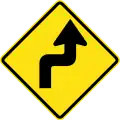 PG-5a
PG-5a
Double sharp curve to the right PG-5b
PG-5b
Double sharp curve to the left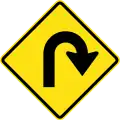 PG-6a
PG-6a
Hairpin curve to right PG-6b
PG-6b
Hairpin curve to left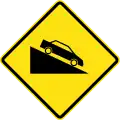 PG-7a
PG-7a
Steep descent PG-7b
PG-7b
Steep descent (trucks)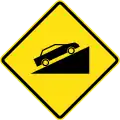 PG-7c
PG-7c
Steep ascent PG-7d
PG-7d
Steep ascent (trucks)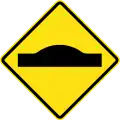 PG-8
PG-8
Speed bumps PG-9
PG-9
Uneven road (with distance in metres)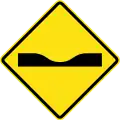 PG-10
PG-10
Dip
Other environment signs
 PF-1a
PF-1a
Road narrows ahead on both sides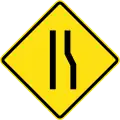 PF-1b
PF-1b
Road narrows ahead on right side PF-1c
PF-1c
Road narrows ahead on left side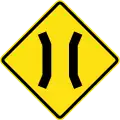 PF-2
PF-2
Narrow bridge PF-3a
PF-3a
Road widens ahead on both sides PF-3b
PF-3b
Road widens ahead on right side PF-3c
PF-3c
Road widens ahead on left side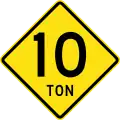 PF-4
PF-4
Weight restriction ahead (10 tonnes (11 short tons))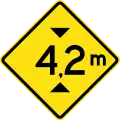 PF-5
PF-5
Height restriction ahead (4.2 metres (14 ft))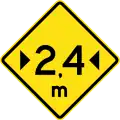 PF-6
PF-6
Width restriction ahead (2.4 metres (7.9 ft))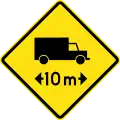 PF-7
PF-7
Length restriction ahead (vehicles over 10 metres (33 ft) long)
Intersection signs
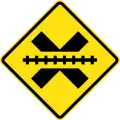 PI-1a
PI-1a
Railway crossing ahead without gates or barriers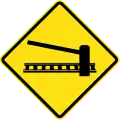 PI-1b
PI-1b
Railway crossing ahead with gates or barriers PI-2a
PI-2a
Railway crossing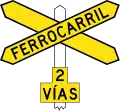 PI-2b
PI-2b
Railway crossing with multiple tracks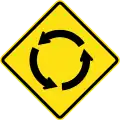 PI-3
PI-3
Roundabout ahead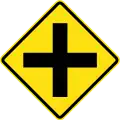 PI-4a
PI-4a
Crossroads ahead PI-4b
PI-4b
T-junction ahead PI-4c
PI-4c
Y-junction ahead PI-4dL
PI-4dL
Minor road ahead on left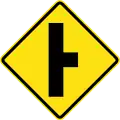 PI-4dR
PI-4dR
Minor road ahead on right PI-4eLR
PI-4eLR
Staggered crossroads, first to the left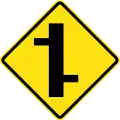 PI-4eRL
PI-4eRL
Staggered crossroads, first to the right PI-4fL
PI-4fL
Traffic merging on the left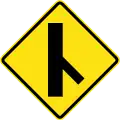 PI-4fR
PI-4fR
Traffic merging on the right
Other signs
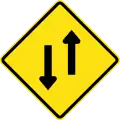 PO-1
PO-1
Two-way traffic ahead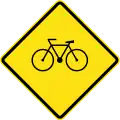 PO-2
PO-2
Watch for cyclists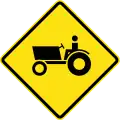 PO-3
PO-3
Watch for farm vehicles crossing PO-4
PO-4
Watch for horse-drawn vehicles crossing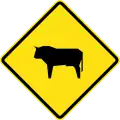 PO-5
PO-5
Domestic animals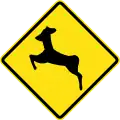 PO-6
PO-6
Wild animals PO-7
PO-7
Pedestrians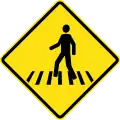 PO-8
PO-8
Pedestrian crossing ahead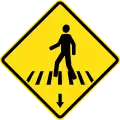 PO-8A
PO-8A
Pedestrian crossing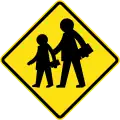 PO-9
PO-9
Children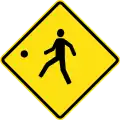 PO-10
PO-10
Playground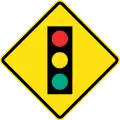 PO-11
PO-11
Traffic lights ahead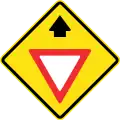 PO-12
PO-12
Give way sign ahead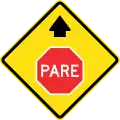 PO-13
PO-13
Stop sign ahead
Special signs
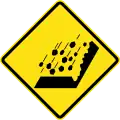 PE-1
PE-1
Watch for falling rocks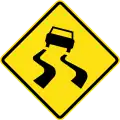 PE-2
PE-2
Slippery road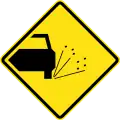 PE-3
PE-3
Loose gravel PE-4
PE-4
Danger of electrical overhead wires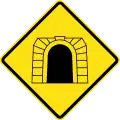 PE-5
PE-5
Tunnel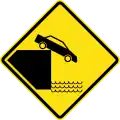 PE-6
PE-6
Unprotected waterfront or quayside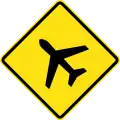 PE-7
PE-7
Airport or airfield nearby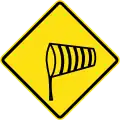 PE-8
PE-8
Dangerous wind gusts PE-9
PE-9
Edge drop PE-10
PE-10
Danger
Temporary signs
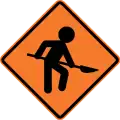 PT-1
PT-1
Road workers ahead PT-2
PT-2
End of road workers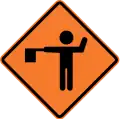 PT-3
PT-3
Traffic flagger ahead PT-4
PT-4
Watch for construction vehicles
Informative Signs
 IP-1
IP-1
Alternative route ID-1a
ID-1a
Exit (Type A) ID-1b
ID-1b
Exit (Type B).svg.png.webp) ID-1
ID-1
Countdown beacon to next exit (100 meters away).svg.png.webp) ID-1
ID-1
Countdown beacon to next exit (200 meters away).svg.png.webp) ID-1
ID-1
Countdown beacon to next exit (300 meters away)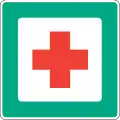 IS-1a
IS-1a
First aid (Type A)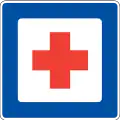 IS-1b
IS-1b
First aid (Type B) IS-2a
IS-2a
Information (Type A) IS-2b
IS-2b
Information (Type B) IS-3a
IS-3a
Telephone (Type A) IS-3b
IS-3b
Telephone (Type B) IS-4a
IS-4a
Petrol (Type A) IS-4b
IS-4b
Petrol (Type B) IS-5a
IS-5a
Post office (Type A) IS-5b
IS-5b
Post office (Type B)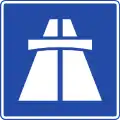 IAA-1
IAA-1
Begin of motorway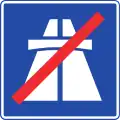 IAA-2
IAA-2
End of motorway IAA-3
IAA-3
Exit IAA-4
IAA-4
Exit ahead IAA-5
IAA-5
Return route IAA-6
IAA-6
Parking ahead IAA-7
IAA-7
Emergency telephone
See also
References
Manual de Señalización de Tránsito, Capítulo 2 (PDF), Comisión Nacional de Seguridad de Tránsito, retrieved 2019-08-04 Introducción Al Manual De Señalización De Tránsito (PDF), Municipalidad de Punta Arenas, retrieved 2019-08-04
- ↑ "United Nations Treaty Collection". treaties.un.org. Retrieved 2023-12-07.
- ↑ "Manual de Señalización de Tránsito - Conaset". Conaset (in Spanish).
